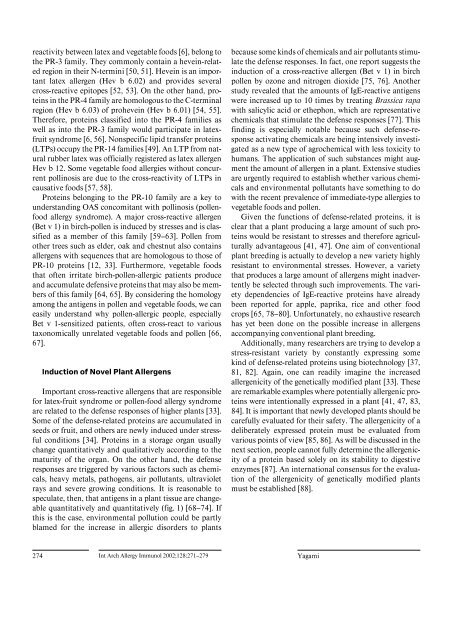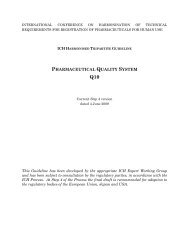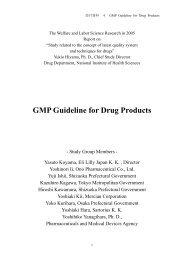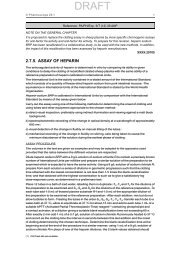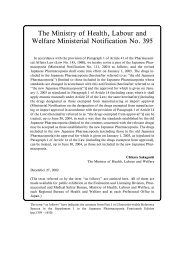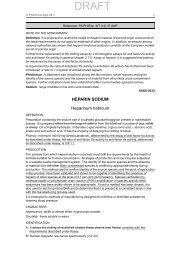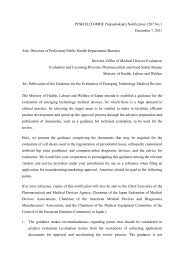Allergies to cross-reactive plant proteins. Latex-fruit ... - NIHS
Allergies to cross-reactive plant proteins. Latex-fruit ... - NIHS
Allergies to cross-reactive plant proteins. Latex-fruit ... - NIHS
You also want an ePaper? Increase the reach of your titles
YUMPU automatically turns print PDFs into web optimized ePapers that Google loves.
eactivity between latex and vegetable foods [6], belong <strong>to</strong><br />
the PR-3 family. They commonly contain a hevein-related<br />
region in their N-termini [50, 51]. Hevein is an important<br />
latex allergen (Hev b 6.02) and provides several<br />
<strong>cross</strong>-<strong>reactive</strong> epi<strong>to</strong>pes [52, 53]. On the other hand, <strong>proteins</strong><br />
in the PR-4 family are homologous <strong>to</strong> the C-terminal<br />
region (Hev b 6.03) of prohevein (Hev b 6.01) [54, 55].<br />
Therefore, <strong>proteins</strong> classified in<strong>to</strong> the PR-4 families as<br />
well as in<strong>to</strong> the PR-3 family would participate in latex<strong>fruit</strong><br />
syndrome [6, 56]. Nonspecific lipid transfer <strong>proteins</strong><br />
(LTPs) occupy the PR-14 families [49]. An LTP from natural<br />
rubber latex was officially registered as latex allergen<br />
Hev b 12. Some vegetable food allergies without concurrent<br />
pollinosis are due <strong>to</strong> the <strong>cross</strong>-reactivity of LTPs in<br />
causative foods [57, 58].<br />
Proteins belonging <strong>to</strong> the PR-10 family are a key <strong>to</strong><br />
understanding OAS concomitant with pollinosis (pollenfood<br />
allergy syndrome). A major <strong>cross</strong>-<strong>reactive</strong> allergen<br />
(Bet v 1) in birch-pollen is induced by stresses and is classified<br />
as a member of this family [59–63]. Pollen from<br />
other trees such as elder, oak and chestnut also contains<br />
allergens with sequences that are homologous <strong>to</strong> those of<br />
PR-10 <strong>proteins</strong> [12, 33]. Furthermore, vegetable foods<br />
that often irritate birch-pollen-allergic patients produce<br />
and accumulate defensive <strong>proteins</strong> that may also be members<br />
of this family [64, 65]. By considering the homology<br />
among the antigens in pollen and vegetable foods, we can<br />
easily understand why pollen-allergic people, especially<br />
Bet v 1-sensitized patients, often <strong>cross</strong>-react <strong>to</strong> various<br />
taxonomically unrelated vegetable foods and pollen [66,<br />
67].<br />
Induction of Novel Plant Allergens<br />
Important <strong>cross</strong>-<strong>reactive</strong> allergens that are responsible<br />
for latex-<strong>fruit</strong> syndrome or pollen-food allergy syndrome<br />
are related <strong>to</strong> the defense responses of higher <strong>plant</strong>s [33].<br />
Some of the defense-related <strong>proteins</strong> are accumulated in<br />
seeds or <strong>fruit</strong>, and others are newly induced under stressful<br />
conditions [34]. Proteins in a s<strong>to</strong>rage organ usually<br />
change quantitatively and qualitatively according <strong>to</strong> the<br />
maturity of the organ. On the other hand, the defense<br />
responses are triggered by various fac<strong>to</strong>rs such as chemicals,<br />
heavy metals, pathogens, air pollutants, ultraviolet<br />
rays and severe growing conditions. It is reasonable <strong>to</strong><br />
speculate, then, that antigens in a <strong>plant</strong> tissue are changeable<br />
quantitatively and quantitatively (fig. 1) [68–74]. If<br />
this is the case, environmental pollution could be partly<br />
blamed for the increase in allergic disorders <strong>to</strong> <strong>plant</strong>s<br />
because some kinds of chemicals and air pollutants stimulate<br />
the defense responses. In fact, one report suggests the<br />
induction of a <strong>cross</strong>-<strong>reactive</strong> allergen (Bet v 1) in birch<br />
pollen by ozone and nitrogen dioxide [75, 76]. Another<br />
study revealed that the amounts of IgE-<strong>reactive</strong> antigens<br />
were increased up <strong>to</strong> 10 times by treating Brassica rapa<br />
with salicylic acid or ethephon, which are representative<br />
chemicals that stimulate the defense responses [77]. This<br />
finding is especially notable because such defense-response<br />
activating chemicals are being intensively investigated<br />
as a new type of agrochemical with less <strong>to</strong>xicity <strong>to</strong><br />
humans. The application of such substances might augment<br />
the amount of allergen in a <strong>plant</strong>. Extensive studies<br />
are urgently required <strong>to</strong> establish whether various chemicals<br />
and environmental pollutants have something <strong>to</strong> do<br />
with the recent prevalence of immediate-type allergies <strong>to</strong><br />
vegetable foods and pollen.<br />
Given the functions of defense-related <strong>proteins</strong>, it is<br />
clear that a <strong>plant</strong> producing a large amount of such <strong>proteins</strong><br />
would be resistant <strong>to</strong> stresses and therefore agriculturally<br />
advantageous [41, 47]. One aim of conventional<br />
<strong>plant</strong> breeding is actually <strong>to</strong> develop a new variety highly<br />
resistant <strong>to</strong> environmental stresses. However, a variety<br />
that produces a large amount of allergens might inadvertently<br />
be selected through such improvements. The variety<br />
dependencies of IgE-<strong>reactive</strong> <strong>proteins</strong> have already<br />
been reported for apple, paprika, rice and other food<br />
crops [65, 78–80]. Unfortunately, no exhaustive research<br />
has yet been done on the possible increase in allergens<br />
accompanying conventional <strong>plant</strong> breeding.<br />
Additionally, many researchers are trying <strong>to</strong> develop a<br />
stress-resistant variety by constantly expressing some<br />
kind of defense-related <strong>proteins</strong> using biotechnology [37,<br />
81, 82]. Again, one can readily imagine the increased<br />
allergenicity of the genetically modified <strong>plant</strong> [33]. These<br />
are remarkable examples where potentially allergenic <strong>proteins</strong><br />
were intentionally expressed in a <strong>plant</strong> [41, 47, 83,<br />
84]. It is important that newly developed <strong>plant</strong>s should be<br />
carefully evaluated for their safety. The allergenicity of a<br />
deliberately expressed protein must be evaluated from<br />
various points of view [85, 86]. As will be discussed in the<br />
next section, people cannot fully determine the allergenicity<br />
of a protein based solely on its stability <strong>to</strong> digestive<br />
enzymes [87]. An international consensus for the evaluation<br />
of the allergenicity of genetically modified <strong>plant</strong>s<br />
must be established [88].<br />
274 Int Arch Allergy Immunol 2002;128:271–279 Yagami


